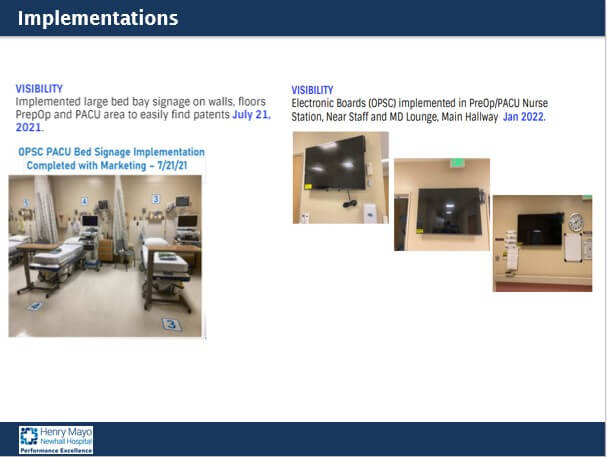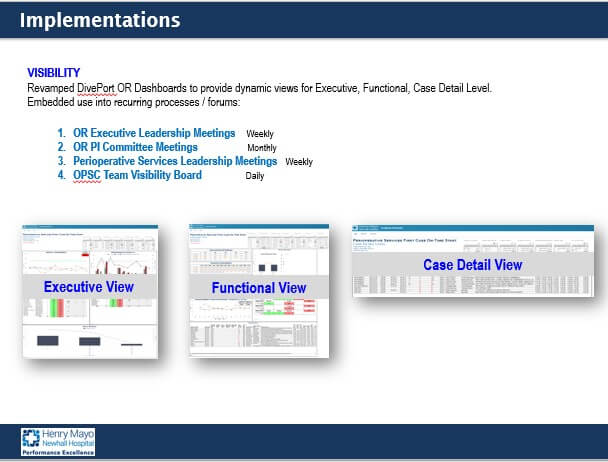For enquiries call:
+1-469-442-0620

- Project Management

Top 15 Project Management Case Studies with Examples 2024
Home Blog Project Management Top 15 Project Management Case Studies with Examples 2024
Having worked for more than 9 years in the dynamic field of project management, I would strongly refer to real-world case studies as invaluable resources for both budding and experienced professionals. These case studies provide critical insights into the challenges and triumphs encountered in various industries, illustrating the application of project management principles in practical scenarios. I have curated the project management case studies as a part of this article in such a way that it delves into a selection of compelling case studies, ranging from the healthcare sector to infrastructure and technology. Each case study is a testament to the strategic planning, adaptability, and innovative problem-solving skills necessary in today's fast-paced business environment. These narratives not only highlight past successes but also offer guidance for future projects, making them essential tools for anyone eager to excel in project management.
What is Case Study?
A case study refers to an in-depth examination of a specific case within the real-world context. It is a piece of content that sheds light on the challenges faced, solutions adopted, and the overall outcomes of a project. To understand project management case studies, it is important to first define what a project is . A project is a temporary endeavor with a defined beginning and end, aimed at achieving a specific goal or objective. Case studies are generally used by businesses during the proposal phase. However, they are also displayed on the websites of companies to provide prospects with a glance at the capabilities of the brands. It can even serve as an effective tool for lead generation. In simple words, case studies are stories that tell the target audience about the measures and strategies that the organization adopted to become successful.
What is Project Management Case Study?
A project management case study is a piece of content that highlights a project successfully managed by the organization. It showcases the challenges that the organization faced, the solutions adopted, and the final results. Keep reading in order to explore examples of successful project management case studies.
Top 15 Project Management Case Studies and Examples
Are you looking for some project management case study examples? If yes, here are some of the best examples you can explore. Let’s dive in! Before diving in, here is the list of top 15 project management case studies:
- Mavenlink Helps Improve Utilization Rates by 15% for BTM Global
- Boncom Reduces Billing Rate Errors by 100%
- whyaye! Reaches 80% Billable Utilization
- Metova Increases Billable Utilization by 10%
- Appetize Doubles Length of Forecasting Outlook
- RSM Improves Client Satisfaction and Global Business Processes
- CORE Business Technologies Increases Billable Utilization by 35%
- Health Catalyst Improves Business Processes and Increases Consistency in Project Delivery
- Optimus SBR Improves Forecasting Horizon by 50%
- PlainJoe Studios Increases Projects Closing Within Budget by 50%
- RPI Consultants Decreases Admin Time by 20%
- CBI's PMO Increases Billable Utilization By 30%
- Butterfly Increases Billable Time by 20%
- TeleTracking Increases Billable Utilization by 37%
- Taylors Improves Utilization Rates by 15%
1. Mavenlink Helps Improve Utilization Rates by 15% for BTM Global
The case study is all about how Mavenlink helped BTM Global Consulting to save hours of work and enhance utilization with resource management technology. BTM Global Consulting offers system development and integration services to diverse clients. The challenges that the company faced were that tools like Netsuite OpenAir and Excel spreadsheets were not able to meet the customization needs as the company grew. It impacted their overall productivity.
BTM Global saw the following benefits:
- 15% increase in utilization for project managers
- 10% increase in companywide utilization
- 4-hour resource allocation work reduced to 10 minutes
- 100% Company-wide time tracking adoption
In order to overcome the challenge, the solution they adopted was to switch to Mavenlink. The result was that it increased the utilization of the company by 10% and enhanced project manager utilization by 15%. It also reduced resource allocation work from 4 hours to just 10 minutes.
2. Boncom Reduces Billing Rate Errors by 100% With Mavenlink
Boncom is an advertising agency that collaborates with different purpose driven brands to create goods worldwide. The challenge was that the company relied on several-point solutions for delivering client-facing projects. However, the solutions failed to offer the required operational functionality. An ideal solution for Boncom was to adopt Mavenlink. The result was that the billing rate error got reduced by 100%. Accurate forecasting became possible for Boncom, and the company could generate reports in much less time.
3. whyaye! Reaches 80% Billable Utilization with Mavenlink
Here are the top benefits whyaye got:
- 6% increase in utilization
- Tripled company size
- Doubled in number of new clients every quarter
- Support through constant business scaling
whyaye is a digital transformation consultancy delivering IT transformation solutions to businesses operating in diverse sectors. The challenge was that whyaye used to manage resources and projects using tools such as emails, PowerPoint, and Microsoft Excel. However, with the growth of the company, they were not able to access project data or gain insights for effective management of the projects . The ultimate solution to this challenge was to make a switch to Mavenlink. The result was an increase in the utilization by 6%, doubling of new clients, tripling of the company size, and seamless support through business growth.
4. Metova Increases Billable Utilization by 10% With Mavenlink
If you are looking for a project planning case study, Metova can be the right example. Metova is a technology firm, a Gold Partner of Microsoft, and an advanced consulting partner of AWS. The challenge was that the company handled several projects at a time. However, its heavy dependence on tools like Google Sheets limited the growth capabilities of the organization. So, the company looked for a solution and switched to Mavenlink. The result was that it was able to increase its billable utilization by 10%, increase its portfolio visibility, and standardize its project management process.
5. Appetize Doubles Length of Forecasting Outlook with Mavenlink
Here the the benefits Appetize got with Mavenlink:
- Forecasting horizon increases to 12 weeks
- Management of 40+ major projects per quarter
- Support for rapid companywide scaling
- Salesforce integration supports project implementation
Appetize is one of the leading cloud-based points of sale (POS), enterprise management, and digital ordering platform that is trusted by a number of businesses. The challenge of the company was that its legacy project tracking systems were not able to meet the growing needs of the company. They experienced growth and manual data analysis challenges. The solution they found was to switch to Mavenlink. The result was an increase in the forecast horizon to 12 weeks, support for effective companywide scaling, easy management of over 40 major projects, and Salesforce integration for project implementation.
6. RSM Improves Client Satisfaction and Global Business Processes with Mavenlink
RSM is a tax, audit, and consulting company that provides a wide array of professional services to clients in Canada and the United States. The challenge of the company was that its legacy system lacked the necessary features required to support their work- and time-intensive projects and delivered insights relating to the project trends. An ideal solution to this challenge was to switch to Mavenlink. The result was better to risk mitigation in tax compliance, improved client-team communication, templatized project creation, and better use of the KPIs and project status.
7. CORE Business Technologies Increases Billable Utilization by 35% with Mavenlink
Here are the top benefits CORE Business Technologies got with Mavenlink:
- Simultaneous in-progress projects doubled
- 100% company-wide time entry compliance
- 35% Increase in Billable Utilization
- 50% Increase in Team Productivity
Another top project management case study is the Core Business Technologies. CORE Business Technologies is a reputed single-source vendor self-service, in-person, and back-office processing to the clients. It offers SaaS-based payment solutions to clients. The challenge faced by the company was that its tools like spreadsheets, Zoho, and Microsoft Project led to a hectic work schedule owing to a huge number of disconnected systems. The solution to the challenge was to switch to Mavenlink. The result was the enhancement of team productivity by 50%, time entry compliance by 100%, and enhancement of the billable utilization rate by 35%.
Discover the leading KnowledgeHut's Project Management Courses:
8. Client Success: Health Catalyst Improves Business Processes and Increases Consistency in Project Delivery with Mavenlink
Here are the top benefits Health Catalyst saw with Mavenlink:
- Consistency in Successful Project Delivery
- Improved Interdepartmental Communication
- Deeper Resource Data Insights
- Stronger Resource Forecasting
Health Catalyst is a company that delivers data and analytics services and technology to different healthcare organizations. The firm provides assistance to technicians and clinicians in the healthcare sector. The challenge of the company was that the tools like Intacct and spreadsheets that is used for project management were not able to provide the required data insights and clarity for better project management. It also limited effective resource management. The solution was to embrace Mavenlink. The result was better resource forecasting, enhanced interdepartmental communication, consistency in project delivery, and better resource data insights .
9. Client Success: Optimus SBR Improves Forecasting Horizon by 50% with Mavenlink
Optimus SBR is a leading professional service provider in North America. It offers the best results to companies operating in diverse sectors, including healthcare, energy, transportation, financial services, and more. The challenge was that legacy software tools that the firm used gave rise to project management issues. The company was not able to get a real-time revenue forecast or gain insights into its future financial performance. The solution that the company adopted was to switch to Mavenlink. The result was better data-driven hiring decisions, efficient delivery of remote work, and enhancement of the forecasting horizon by 50%.
10. Client Success: PlainJoe Studios Increases Projects Closing Within Budget by 50% With Mavenlink
Here are the benefits how Mavenlink helped PlainJoe:
- Improved data insights for project success
- Enablement of fast shift to remote work
- Improved budgeting
- Increased rates in billing
PlainJoe Studios is an experimental design studio that focuses on digitally immersive and strategic storytelling. The company has a team of strategists, architects, and problem solvers to create value for the clients. The challenge of the company was that the manual processing of the company affected its ability to grow and manage the diverse project effectively. They lacked clarity about their project needs and profitability. The solution to deal with the challenge was to switch to Mavenlink. The result was an enhancement in the billing rates by 15%, better project closing within budget by 50%, better data insights for the success of different projects, and a faster shift to remote work.
11. Client Success: RPI Consultants Decreases Admin Time by 20% With Mavenlink
If you are looking for an example of one of the best software project management case studies, then RPI Consultants can be the ideal one. RPI Consultants offer expert project leadership and software consulting services for enterprise-level implementation of solutions and products. The challenge was that the task management solutions adopted by the company gave rise to a number of complications. It resulted in poor interdepartmental transparency and time-consuming data entry. The ultimate solution that the company embraced was to switch to Mavenlink. The result was a rise in the utilization rate by 5%, lowing of admin time by 20%, better forecasting and resource management, and a single source for gaining insights into the project data.
12. Client Success: CBI's PMO Increases Billable Utilization By 30% With Mavenlink
CBI is a company that is focused on protecting the reputations, data, and brands of its clients. The challenge that the company faced was that the solutions used were unable to meet the growing needs of the organization. The systems were outdated, data sharing was not possible, and time tracking was inconsistent. The solution to the challenge was to switch to Mavenlink. The result was better interdepartmental alignment, enhancement of time tracking to support business growth, an increase in the billable utilization rate by 30%, and detailed insights for a greater success of the projects.
13. Client Success: Butterfly Increases Billable Time by 20% with Mavenlink
Butterfly is a leading digital agency that provides digital strategy, website design and development services, and ongoing support to businesses across Australia. The challenge was that the different legacy systems used by the agency limited its capability of effective project management and reporting. The systems were time consuming and cumbersome. In order to deal with the challenge, the solution was to make a switch to Mavenlink. The result was the enhancement of billable time by 20%, fast reporting insights, enhancement of productive utilization by 16%, and better Jira integration.
14. Client Success: TeleTracking Increases Billable Utilization by 37% With Mavenlink
TeleTracking Technologies is a leading provider of patient flow automation solutions to various hospitals in the healthcare sector. The challenge of the company was that it used different systems such as Microsoft Excel, Sharepoint, MS Project, Jira, and Netsuite. The use of a variety of solutions created a number of challenges for the company. It had poor forecasting capability, an insufficient time tracking process, and unclear resource utilization. The solution was to switch to Mavenlink. The result was the enhancement of time tracking compliance by 100%, rise in hours to date by 18%, and enhancement of billable utilization by 37%.
15. Client Success: Taylors Improves Utilization Rates by 15% with Mavenlink
This is a perfect example of a construction project management case study. Taylor Development Strategists is a leading civil engineering and urban planning organization in Australia. The challenge that the company faced was that the systems that it used were not able to support the growth of the business. There were a lot of inefficiencies and limitations. The solution to the challenge was to switch to Mavenlink. The result was better global collaboration, an increase in the utilization rate by 15%, consistency of timesheet entry, and in-depth insights relating to utilization and project targets.
Top Cities where Knowledgehut Conduct Project Management Certification Training Course Online
Transform your management approach with our online agile courses . Discover how to adjust, cooperate, and create like never before.
Start Creating Your Project Management Case Study
Not that you have a detailed idea about project management case studies, it is time to prepare your own. When doing the project management case study exercise, make sure to focus on covering all the important elements. Clearly stating the challenges and the solutions adopted by the company is important. If you want to get better at project management, getting a PMP Certification can be beneficial.
Case Study Best Practices and Tips
.png&w=3840&q=75)
- Involve your clients in the preparation of the case study.
- Make use of graphs and data.
- Mix images, texts, graphs, and whitespace effectively.
Project Management Case Studies Examples
Hospital el pilar improves patient care with implementing disciplined agile.
If you are looking for an example of one of the best hospital related project management case studies, then Hospital El Pilar can be the ideal one. Hospital El Pilar is a private hospital in Guatemala City, Guatemala, that provides comprehensive care to patients in various medical specialties. The challenge was that the hospital’s application development team faced several obstacles in managing and delivering projects, such as unclear priorities, a lack of visibility, little interaction with users, and competing demands. The solution that the team adopted was to use Disciplined Agile® (DA™), a flexible and pragmatic approach to project management that optimizes the way of working (WoW). The result was improved project outcomes, increased user satisfaction, greater transparency, and more trust from stakeholders and customers.
British Columbia’s Ministry of Technology and Infrastructure (MoTI) gets its principal corridor for transportation up in 35 days
Reconnecting Roads After Massive Flooding (2022) is a case study of how the British Columbia Ministry of Transportation and Infrastructure (MoTI) used a project management approach based on the PMBOK® Guide to restore critical routes after a catastrophic weather event. It is one of the examples of successful project management case studies you can look into. The challenge was that an atmospheric river caused severe flooding, landslides, and bridge collapses, cutting off the lower mainland from the rest of Canada2. The solution was to prioritize the reopening of Highway 5, the principal corridor for transportation of goods and people, by creating scopes, work breakdown structures, and schedules for each site3. The result was that Highway 5 was reopened to commercial traffic in 35 days, despite additional weather challenges and risks4. The construction project management case study we discussed demonstrated the benefits of flexibility, collaboration, and communication in emergency response.
Project Management Case Study Template
To create a well-crafted and highly informative case study template in the realms of project management, you should start by providing a brief overview of the client's company, focusing on its industry, scale, and specific challenges. Follow with a detailed section on the challenge, emphasizing the unique aspects of the project and obstacles faced. Next, you might want to describe the solution implemented, detailing the strategies, methodologies, and tools used. Then, you would need to present the results, quantifying improvements and highlighting objectives achieved. Finally, please conclude the case study with a summary, encapsulating key takeaways and emphasizing the project's success and its implications for future endeavors. By following this structure, you can present a comprehensive yet concise analysis that is ideal for showcasing project management expertise and insights. You can also refer to the template for crafting a better case study on project management – Template for writing case studies.
By now, you must have gained a comprehensive knowledge of preparing a project management case study. This article elaborately explains the significance of real life project management case studies as vital tools for demonstrating a company's expertise in handling complex projects. These case studies, showcasing real-world scenarios, serve as compelling evidence of a firm's capability to navigate challenges and implement effective solutions, thereby boosting confidence in potential clients and partners. They are not only a reflection of past successes but also a lighthouse guiding future project endeavors in the discipline of project management within the fields of construction, pharmacy, technology and finance, highlighting the importance of strategic planning, innovation, and adaptability in project management. If you are aspiring to excel in this field, understanding these case studies is invaluable. However, you would also need to learn from project management failures case studies which would provide a roadmap to mastering the art of project management in today's dynamic business landscape.
Frequently Asked Questions (FAQs)
In order to write a project management case study, keep everything brief but mention everything in detail. Make sure to write it with clarity and include graphs and images.
A project study must include information about the client, how your company helped the client in resolving a problem, and the results.
The best-case studies on project management have been listed above. It includes BTM Global, Butterfly, Boncom, and more.

Kevin D.Davis
Kevin D. Davis is a seasoned and results-driven Program/Project Management Professional with a Master's Certificate in Advanced Project Management. With expertise in leading multi-million dollar projects, strategic planning, and sales operations, Kevin excels in maximizing solutions and building business cases. He possesses a deep understanding of methodologies such as PMBOK, Lean Six Sigma, and TQM to achieve business/technology alignment. With over 100 instructional training sessions and extensive experience as a PMP Exam Prep Instructor at KnowledgeHut, Kevin has a proven track record in project management training and consulting. His expertise has helped in driving successful project outcomes and fostering organizational growth.
Avail your free 1:1 mentorship session.
Something went wrong
Upcoming Project Management Batches & Dates
Project Management Examples: Success Stories Case Studies, and Examples
By Kate Eby | January 3, 2023
- Share on Facebook
- Share on LinkedIn
Link copied
The best real-world project management starts with meticulous planning and ends with achieving goals. Take charge of your next project with the techniques and tools that experts use to avoid failure and deliver stellar results.
In this article, learn about eight real-world project management examples , project success criteria , five famous project management failures , and how modern project management software supports success .
Successful Real-World Project Management Examples
Successful real-world project management examples have one thing in common: they support company strategy. Examples show how detailed research, planning, and organization of resources helped real-world project managers achieve a particular aim that moves the organization forward.
Successful project management examples reveal that, in order to reach the final goal, you must have and maintain a big-picture view. Other success factors include involving stakeholders, reviewing multiple frameworks and solutions, and keeping the lines of communication open.
Henry Mayo Newhall Hospital Case Study: Increased Outpatient Surgical Center Performance

Henry Mayo Newhall Hospital is a 357-bed not-for-profit community hospital and trauma center in Santa Clarita, California. Jay Arcilla, Director of the Performance Excellence Office, is charged with studying and adapting the functions and processes to increase the achievement of desired outcomes, better meet patients' needs, and assure quality.
- Challenge: In every hospital, starting the day's first scheduled in-patient or out-patient surgery on time has a knock-on effect on subsequent surgery timelines. Meeting schedules can always be challenging. The pandemic created even more hurdles, from having the right supplies and equipment on hand to keeping up with documentation and ensuring the right personnel are available to cover every patient's needs. Arcilla focused on raising surgery on-time start times to 70 percent.

- Work Sessions: A team work session helps frontline staff analyze the root cause and create a consensus-driven, interdisciplinary team.

- Communication: Disseminating information and encouraging discussion for all stakeholder groups.
- Accountability: The operating room executive leadership created and enforced an Outpatient Surgery Center First Case On-Time Start (OPSC FCOTS) Escalation Plan, holding all staff accountable for showing up to first cases on time.
- Takeaway: In complex, multi-layered project situations, there is often no single silver bullet. Instead, results manifest over time. In this case, within seven months, monthly performance went past the 70 percent target to 89 percent for April 2022.
Behr Process Corporation Case Study: Paving the Way for Road Show Marketing Achievement

Behr is one of the largest purveyors of architectural paint and exterior wood care products in the United States and Canada. Lisa Kudukis, Director of Professional Products and Services for the Behr Process Corporation , oversees promotions, including a major road show.
- Challenge: Kudukis created the BehrPro Experience Tour to connect with U.S. contractors. The annual event employs five tour teams covering 75 markets and 500 Home Depot locations in 34 states. Initially, each manager used different tools and organizational tactics to run their activities. Supervising people and processes and collaborating to maximize efforts was challenging. The Behr marketing team needed a way to operate more efficiently and stay on task.
- Solution: After an exhaustive review, Kudukis chose Smartsheet as the group's project management tool. Everyone on the team now uses a single, custom template. A master dashboard relays information about key initiatives and features a drill-down menu so anyone with access can check on small details.
- Takeaway: For the team, it is a huge time and money saver since anyone can view the project status and provide assistance if necessary. It also helps the team identify new business development opportunities or obstacles to inform future promotions and projects.
Successful Software Project Examples
Software projects involve generating an overall plan, scheduling, allocating resources, executing, tracking, and delivering quality software and apps. These examples show that successful software projects deliver the product with the pre-agreed level of quality within the given time and cost.
Software companies create, change or maintain valuable products. Software project management is one of the most complex and fastest-growing endeavors in business today.
Hyland Software: More Responsive Updates and Website Requests

Jacob Huston-Lowery manages web operations at Hyland Software , a content services platform and developer of Onbase, an enterprise content management (ECM) and process management software suite. Hyland cuts dozens of hours from the website request process while capturing data to drive ongoing improvement for its clients. Clients include insurance, manufacturing, higher education, and finance businesses that provide web-based services to their customers.
- Challenge: Providing efficiency and seamless services is paramount to maintaining Hyland's standards. Service requests from internal staff who noticed system issues, along with those on behalf of customers, created log jams and confusion. When Huston-Lowery came on board, there were five different contact forms, and some requesters were bypassing the process and sending emails.
- Solution: Huston-Lowery turned to Smartsheet to find an easy-to-use solution for the critical challenges his team faced. Using project messaging and alerts within the app helped eliminate email delays. When users complete an online form with an alert for urgent projects, Smartsheet routes website requests to a sheet Huston-Lowery manages. As requests come in, all projects are prioritized, scheduled, and assigned to team members or third-party website management agencies.
- Takeaway: By replacing email trails with built-in alerts and update capabilities, the Smartsheet solution saves communication time and eliminates duplication. The ability to handle requests strategically helps the team implement a support program that runs 24 hours a day, 5 days a week – a process that was impossible before instituting the new project management process.
Examples of Successful IT Projects
Information technology (IT) projects ensure that software, devices, and systems work together to help people get things done.
Managing IT projects and creating efficient IT project plans involve all aspects of planning, design, implementation, project management, and training.
Convergint: A Single System of Record Improves Processes and Customer Service

Jenn Hilber is the Business Architect, Operations for Convergint , the largest privately held security integrator in the United States. Convergint has more than 175 locations worldwide, providing a range of services, including installation and management of card readers and cameras, alarm systems, fire systems, building controls, and more.
- Challenge: The company prides itself in creating an outstanding customer experience, but managing all the details seamlessly was difficult. Convergint relied on manual practices and printed playbooks, with no single unified process for most of its activities.
- Solution: Convergint turned to Smartsheet to capture all of its data, best practices, and resources in a single place. As a result, teams can make strategic decisions and act on customer priorities with confidence knowing that they have the most current and accurate information at their fingertips.
- Takeaway: Convergint teams now enjoy better cross-team and global communication, a clearer insight into customers' needs and status, and greater accountability for internal processes. Customers also experience quicker turnaround time for requests.
Exoft: Shifting to Mixed Methodologies Rescue an IT Project Management Client Relationship

Bohuslava Zhyvko is Head of Marketing for Exoft , a software development services company located in Lviv, Ukraine. Exoft builds robust web and mobile solutions with a focus on increasing clients' efficiency and solving technology challenges.
- Challenge: Zhyvko began a new assignment with an IT client previously managed by another project manager. Zhyvko learned the IT client didn't want to hear about Agile methodology or process at Exoft; he simply wanted to complete his project ASAP.
- Solution: Zhyvko immediately requested a kick-off conference call. During the call, she discussed the goal and purpose of the project and clarified the main issues that were creating stress points. After the call, Zhyvko gathered the team and included Exoft's CTO. The weaknesses of the client's planning and reporting systems became apparent, and Zhyvko offered the solution: Agile, after all. The team used a mix of Scrum and Kanban to replace Waterfall , which wasn't the right approach for the nature and goals of the project. They divided the project's scope into milestones and sprints, then switched the look of the workboard in Jira. Zhyvko supplied the client with a process improvement proposal and SOW with all the features he wanted. Zhyvko explained how the project's formal change request procedure worked and shared the documentation, so the client could clearly understand the development process, which they accepted and signed.
- Takeaway: After three months, when two milestones were closed, the client was pleased with the deliveries and the Scrum working process. The project concluded after milestone 11 with a client who was pleased with the outcome. His startup is growing extremely fast, and the company and Zhyvko have an excellent relationship. Solid planning, reporting, and communication can turn around even the most complex project management challenge.
Examples of Successful Completed Business Projects
Efficiently reaching project objectives is a key element of project management success. Efficiency relates to how the project’s limited resources are managed to meet its goals while building good relationships with internal and external stakeholders.
Whirlpool: Regional Alignment for Smoother Operations

Thiago Zapparoli is a Senior Planning Engineer at Whirlpool Corporation . The global home appliance company relies on regional project managers to manage its extensive portfolio.
- Challenge: When you're responsible for managing a project portfolio of a global home appliance company — including approximately 400 individual projects across five worldwide regions — you need a comprehensive system to keep everything on track. That's why Zapparoli looked for a way to get project managers, leadership, and other stakeholders on the same page with the laundry and dryer portfolio he manages.
- Solution: Zapparoli knew he needed an effective and unique system for all project managers to aggregate the 400 projects that covered multiple regions around the globe. At a minimum, the project management system needed to identify responsibilities for each project and task; key performance indicators; and open, completed, and delayed tasks. Smartsheet offered an all-up view of an entire region, providing real-time visibility into the overall project status and numerous tasks. First deployed in Brazil, the holistic tracker transformed how the 10 project managers and cross-functional leaders in that region approach their daily work and stay in sync.
- Takeaway: After implementations in Brazil and the United States, Zapparoli’s Smartsheet trackers are used in all three remaining regions and assisted deployment in four other Whirlpool internal organizations. Project managers are engaged because they have control over projects. Cross-functional leaders are satisfied with the visibility, and senior leadership can now see how they can help.
Simplus: Improved Sales Process

Katherine Albiston is a Content Manager for Simplus , an Infosys company that provides a strategic, industry-focused digital transformation for customers in the Salesforce ecosystem. She shares how Simplus’ customer Ziehm Imaging needed to improve its sales process to garner maximum efficiency and profits, as well as the company’s solution for them.
- Challenge: Simplus customer Ziehm Imaging, Inc. was using a legacy configure, price, quote (CPQ) system process for defining new products or modifying bundles. As a result, it took up to a week to go to market. A Microsoft Excel-based process further complicated managing market-specific annual pricing updates, which required a manual price override to apply pricing for each segment. The manual work increased errors, eroded margins, and led to customer communications about pricing adjustments – not good for relationships.
- Solution: Simplus simplified Ziehm's bundle configuration process and centralized compatibility management rules. It now uses a lookup-based rules setup for products that enforces business policies in real time as sales reps interact with the CPQ system.
- Takeaway: Streamlining and installing coherent systems decreased Ziehm's quote creation time by 93 percent, troubleshooting time by 87 percent, and the time to add products by approximately 87 percent. The lesson is clear: A holistic approach to process improvement can reap impressive benefits.
designdough: A More Refined Recruitment Process

Molly Govus is the Marketing Manager of designdough , a full-service U.K. design firm. The company tightened its use of project and time management tools to run projects and realized it needed to do the same for managing internal projects.
- Challenge: designdough audited its recruitment process and discovered four key issues: Permanent and temporary staffing ebb and flow was always in flux depending on client project demands. There were no clear start-to-finish timescales, and they lacked transparency with staff regarding project timescales. Staff capacity related to assigned tasks was unclear. Finally, the firm lacked designated client communication points.
- Solution: They started by planning and documenting every resource and task using a project management tool that provided visibility for all team members. They wanted to clarify the audit's issues and organize information and project processes around recruiting by implementing clearly delineated stages (Administration, Interview, Offer, Induction, and Confirmation). Now, they set start dates for each step and complete tasks before moving to the next stage. Additionally, they add relevant tags, such as meeting , to tasks so they can easily identify who is assigned the task assignment and dates attached to every job.
- Takeaway: Thanks to a straightforward process and an efficient project management tool, the team met its recruitment project goals. They now encounter fewer bottlenecks and have an easier recruitment process that has improved staff and client satisfaction and relationships.
What Is the Measure of Project Success?
The measure of project success is meeting the initial criteria established by the internal or external client and the project team. Teams use these specs, milestones, and deliverables to evaluate a project after it closes.

“Project managers are experts at helping people define problems,” notes J. Scott, CEO of 120VC and author of The Irreverent Guide to Project Management . “Data drives and measures success to control the outcome and move the project forward as aggressively as possible, leaving no time or money on the table.”
In its 2020 report, “Ahead of the Curve: Forging a Future Focused Culture,” the Project Management Institute (PMI) found that organizations that operated from mature ROI capabilities geared toward meeting strategic goals, working within predetermined budgets, delivered segments and the entire project on time with limited scope creep . High-maturity companies had 50 percent fewer project failures than low-maturity organizations.
A success measurement framework includes:
- Buy-In: Worthy projects and outstanding ideas can fail if critical stakeholders aren't behind the effort. With buy-in, resources will be available, and you can move the project forward.
- Strategic Approach: One of the best ways to guarantee buy-in is to make a business case that shows how the project fits into overall company goals and will positively impact the organization’s future. According to an article on the six questions to ask before starting a big project in the Harvard Business Review, a good distribution of resources is 60 percent in support of the core business, 30 percent in the adjacent business area, and 10 percent unrelated to your core business.
- Meticulous Planning: Completing projects on budget and on schedule relies on thorough advanced planning. Professional planning includes defining the scope and objectives of the project and operating from an understanding of the resource and budget limitations that affect your project.
- Continuous Monitoring: Once the project begins, it's essential to monitor all activities, resources, and expenditures almost constantly. You will likely find that you’ll need to make adjustments to some elements in every project. You will want to monitor the execution of tasks against milestones, keep an eye on quality, track whether you are on schedule, and verify money is spent according to plan.
- Make Relationships a Priority: Stay in touch with clients, vendors, and internal team members to stay informed about project status and build relationships. Once the project concludes, check in with stakeholders to see what worked and what didn't so that you can apply winning strategies and tactics to subsequent projects.
Setting Success Metrics
For the best results, the only way to measure project failure or success is by collecting and tracking data from the first day until the project closes. "You can't manage what you don't measure" is Peter Drucker’s time-honored adage for setting project success metrics.
Management consultant Drucker's gold standard in project management metrics is his specific, measurable, achievable, realistic, and time-bound goals framework, known as SMART . To start setting those strategic types of project metrics, the Performance Management Institute (PMI) suggests asking three questions to inform the metrics you will use to measure the success of your project .
The key questions to help set metrics are the following:
- Why is the project needed? Understand the purpose or goal of the project or work.
- What are the success factors? Determine what critical success factors are mandatory for you to succeed and achieve the goal.
- What are the metrics? Identify how you will measure the fulfillment for each critical success factor for the project or program, and collect and share data.
Common Project Management Success Metrics
Metrics for on-target project management track productivity, assess resource utilization, monitor the scope of work changes, and measure quality. Assuring a low number of defects throughout the project and providing a quality deliverable at its end should be a metric for any project.
Examples of crucial project metrics include the following:
- Resource Utilization: This metric assesses how individual team members or the project team spend their time against the total number of hours allocated for the project. Periodically checking time spent on the project can help assess how human energy is being used. For organizations that bill hours, this is an important metric to monitor and review at the end of a project.
- Schedule Variance: This metric helps project managers determine if projects are running according to the planned budget or ahead of it. A negative schedule variance means the project is behind schedule.
- Cost Performance: This metric measures efficiency. Divide the work performed or earned value by how much money it took to accomplish tasks. Accurate budget estimates rely on forecasting cost performance.
- Cost Variance: This metric pinpoints how you are operating within a planned budget. The purpose is to see if you are running below or within budget. If cost variance is negative, the project is over budget. If it’s under budget, that means you are achieving budget and project success.
- Gross Margin: A strategically planned project aims to contribute to the company by increasing profits. The gross margin is the difference between the total income and total project spend. It’s best to establish the gross target margin before a project begins and measure it on an ongoing basis. Achieving or exceeding a gross margin is the primary mark of project management excellence.
With project metrics in place and the right tools to track that data, it is easier to crunch the numbers on previous projects to see what went right and what task ended up causing a significant delay.
What Skills and Tools Support Project Management Success?
You need various tools and skills to guide projects to the desired goal. Soft skills are people skills or emotional intelligence. Hard skills are specific to project managers and can be learned through formal training or on the job.
The exact project management techniques and tools you need depend on your industry, company, and team preferences. The vital foundation for success is to create your project plan and lean into best practices that focus on organization, communication, and team leadership. "There are many methodologies project managers employ," says 120VC’s J. Scott. "Waterfall, Agile, Lean, and more – but the most important skill to have is leadership and a people-centric framework since it is people that get [expletive] done.”
Project management skills and tools to help you meet project management challenges – and win – include the following:
- Soft Skills: Soft skills are interpersonal skills such as communication, flexibility, leadership, teamwork, and time management.
- Project Management Tools: Tools is another word for software. Purpose-built project management software supports teams in the planning, tracking, and managing of projects to meet stated goals on time and within budget. These also serve as a repository for data that will inform the post-project analysis.
- Project Management Methodologies and Frameworks: The Project Management Body of Knowledge (PMBOK) Guide describes all the PM methodologies and techniques available to manage projects. Project managers choose frameworks such as Critical Chain Project Management, Lean, Scrum, and Waterfall for their projects.
Reasons Projects Fail and How Modern Project Software Supports Success
Projects fail for many reasons. Those include inadequate preparation, poor documentation and tracking, and poor communication. Modern project software can help solve those problems and support success.
"Project management, particularly at the enterprise scale, is about getting to desired outcomes as efficiently as possible under any conditions," says 120VC's Scott. "You must be agile (with a lowercase a) to get things done to reach those outcomes." Modern software is the way forward.
“IT projects have an exceptionally high failure rate of 44 percent,” says Scott. “These projects fail due to a lack of alignment between business and project objectives. As software project failure statistics show, the lack of alignment of projects with the business objectives is why nearly half of the strategic initiatives fail.”
5 Famous Project Management Failures and How They Could Have Been Solved
Project management failures are part of most projects. The key is to learn from past failures and track projects closely to get back on track when things go awry.
1. Citibank Interest Payment Failure Citibank intended to make a $7.8 million interest payment to creditors of its client Revlon. Instead, the company paid $900 million because of errors due to aging software. Citibank's employees set up a transaction as if they were paying off the entire loan to calculate the interest correctly, then check numerous boxes to deliver the majority of the sum to an internal Citibank account. Three different people signed off on this transaction, most of which wasn't due to creditors until 2023, but the Citibank employees didn’t check all the proper boxes. Creditors kept more than $500 million of the payment. A judge ruled that they didn't have to return the money because he said it was not believable that one of the largest and most sophisticated financial institutions on earth could make such a mistake.
- Takeaway: The big lesson is to modernize your software and user interfaces, so employees can perform their duties in a streamlined, logical fashion. Remember: You might suffer less when you make mistakes if people aren't angry enough to take advantage of those errors.
2. J.C. Penney Rebrand Failure Ron Johnson, who has a successful branding track record, took over as J.C. Penney's CEO in 2011. Johnson's "cheap chic" rebranding for Target was enormously successful, as was his previous work with Apple to generate its outstanding and consistent brand experience. Defying expectations, Johnson's rebrand for Penney's was a dismal failure. His goal was to revitalize the chain by making "hip" changes. He wanted to shake things up at the company by doing away with sales and coupons, nixing some of the legacy merchandise, and modernizing the store’s physical layout. It failed miserably. Revenues dropped from an already low level, and after 17 months, Johnson was out.
- Takeaway: No matter how cool or innovative a new brand concept seems, robust market research is mandatory. J.C. Penney's poor financial state forced Johnson to act too quickly. As such, he failed to align the likes and dislikes of J.C. Penney's loyal existing customer base with new tactics. That's not to say the change involved in rebranding has to be totally at the mercy of your customers' extant preferences. When a brand has long-standing customer favorite factors such as discounts and coupons, it may be best to roll out changes slowly rather than all at once to acclimate existing customers to a new direction.
3. McDonald's Arch Deluxe Burger The fast food giant put an unprecedented $150 million into advertising for the Arch Deluxe Burger, only to discover its customers weren't interested in the sophisticated, ”gourmet” menu option. Mistakes include marketing to a new, disinterested Gen X demographic while neglecting the brand's core audience, overpricing the burger to cover the additional costs it took to create, and franchisee disinterest.
- Takeaway: The message is to never ignore your buying base and pick the right metrics when you start and run a project. If McDonald's had a more accurate picture of what its customers wanted and conducted more testing with existing customers, the company could have saved its money, resources, and reputation.
4. Dyson Electric Car James Dyson spent a small fortune – more than $600 million – on a seven-seat electric car with a 600-mile range. Then Dyson scrapped it before the prototype ever hit the road. Electric vehicles are costly, and the battery, battery management, electronics, and cooling system are much more expensive than an internal combustion engine. Tesla — hailed as a success by many — has burned through $19 billion of investor cash and is still not profitable. It turned out that each Dyson would have had to fetch roughly $183 million to break even.
- Takeaway: The British government wants to ban sales of all fossil-fuel cars by 2035, so Dyson shifted its focus. The company continues to work on solid-state battery manufacturing. Solid-state batteries are the key to making electric vehicles functional and desirable. Highly efficient, as well as smaller and lighter than ion batteries, solid-state batteries generate less heat and are easier to recycle. Dyson says he could return to electric vehicle production when commercial and financial circumstances change.
5. Coca-Cola and New Coke The company tested New Coke with 200,000 consumers. Most people who tried it preferred New Coke over the traditional product. Based on that information, Coca-Cola launched New Coke in 1985. But the new product did not sell, and product loyalty and people’s old-fashioned habits got in the way. The cost to the company was $30 million in unsellable backstock and $4 million lost to development. New Coke remains one of the most famous failures in marketing history.
- Takeaway: While Coca-Cola researched the market, it missed the mark when assessing the power of brand loyalty. Understanding customers is imperative in product development. Ensure your information is comprehensive and those insights are realistic and accurate.
How Modern Project Management Software Cures Common Project Woes
Modern project management software provides real-time visibility into work conducted across projects, programs, and processes. Store, track, manage, and automatically report on all work, so you can save time and help your team focus on the work that matters most.
Take Charge of Your Next Project with Real-Time Work Management in Smartsheet
From simple task management and project planning to complex resource and portfolio management, Smartsheet helps you improve collaboration and increase work velocity -- empowering you to get more done.
The Smartsheet platform makes it easy to plan, capture, manage, and report on work from anywhere, helping your team be more effective and get more done. Report on key metrics and get real-time visibility into work as it happens with roll-up reports, dashboards, and automated workflows built to keep your team connected and informed.
When teams have clarity into the work getting done, there’s no telling how much more they can accomplish in the same amount of time. Try Smartsheet for free, today.
Discover a better way to streamline workflows and eliminate silos for good.
View or edit this activity in your CPD log.
Project Management
The teaching cases in this section address the challenges related to implementation and scale faced by project managers in a variety of settings.

Shoring Up Child Protection in Massachusetts: Commissioner Spears & the Push to Go Fast
Publication Date: July 13, 2023
In January 2015, when incoming Massachusetts Governor Charlie Baker chose Linda Spears as his new Commissioner of the Department of Children and Families, he was looking for a reformer. Following the grizzly death of a child under DCF...

Architect, Pilot, Scale, Improve: A Framework and Toolkit for Policy Implementation
Publication Date: May 12, 2021
Successful implementation is essential for achieving policymakers’ goals and must be considered during both design and delivery. The mission of this monograph is to provide you with a framework and set of tools to achieve success. The...

Different Approaches to Building a Unified Government Website in Argentina, Peru, and Mexico
Publication Date: August 21, 2020
Government digitization has proven to benefit both citizens and public agencies. On the one hand, citizens are able to find a consistent interface and reliable information on a single site and are able to access streamlined digital government...

Mothers of Rotterdam: Scaling a Social Services Program in the Netherlands
Publication Date: June 7, 2018
Board Chair Nanne Boonstra was about to learn the details of a scaling strategy proposal for Mothers of Rotterdam, a fledgling social service program that helped the city’s disadvantaged pregnant women.Boonstra’s employer, a venture...

Lesotho Hospital and Filter Clinics: A Public-Private Partnership Sequel
Publication Date: October 17, 2016
This sequel accompanies case number 1999.0. This case looks at a public-private partnership (PPP) between the Health Ministry for the government of Lesotho and a private consortium headed up by Netcare, a South African company, to build and...

Lesotho Hospital and Filter Clinics: A Public-Private Partnership
Publication Date: October 03, 2013
This case looks at a public-private partnership (PPP) between the Health Ministry for the government of Lesotho and a private consortium headed up by Netcare, a South African company, to build and operate a new referral hospital and four feeder...

TransMilenio: The Battle Over Avenida Séptima
Publication Date: May 10, 2011
In August of 2007, the mayor of Bogotá, Luis Eduardo Garzón, had to decide whether to proceed with plans to build a Bus Rapid Transit (BRT) line in Avenida Séptima, one of the most important transportation corridors in the...

California High-Speed Rail
Publication Date: November 18, 2010
In January 2010, the California High Speed Rail Authority (CHSRA) was waiting to hear whether the Obama Administration would approve its application for $4.7 billion in federal stimulus funding to begin the construction of a $50-billion,...
Harambee Youth Employment Accelerator: A Model for Reducing Unemployment in South Africa
Publication Date: April 20, 2023
In the fourth quarter of 2021, South Africa's unemployment rate rose to 35%, the highest since 2008. Though some of the job losses could be attributed to the Covid-19 pandemic, the country had already been experiencing high unemployment...


Health Care & the Isolated Poor in the Lower Rio Grande Valley: The Quest to Make a Lasting Change (Sequel)
Publication Date: December 14, 2006
The spring of 2005 marked a tricky juncture for the leaders of a program designed to improve health care access for thousands of residents living in impoverished, isolated settlements just north of the Mexican border in the Lower Rio Grande...

Health Care & the Isolated Poor in the Lower Rio Grande Valley: The Quest to Make a Lasting Change

To What End? Re-thinking Terrorist Attack Exercises in San Jose (Sequel, part 2)
Publication Date: November 03, 2005
This case study tells the story of San Jose, California, one of the first 27 cities in the country to participate in a federal domestic preparedness program. Between 1997 and 1999, a specially created city task force mounted several full-scale...
Case Studies
This page provides an overview of the various case studies available from Scrum.org. These case studies demonstrate successful transforming organizations, uses of Scrum, Nexus, Evidence-Based Management and more. Read them to understand where people and teams have struggled and how they have overcome their struggles.
Organizational and Cultural Transformation
Scaling scrum, successfully implementing scrum, scrum outside of software.
Search All Case Studies
What did you think about this content?
- Leadership Team
- Our Approach
- PMO Services
- Program & Project Managers
- PM Training & Development
- Case Studies
- Our Culture
- Employee Benefits
- Job Opportunities
- Benefits Realization Management Diagnostic
- Project Management Maturity Guide
- Guide to Agile Project Management
- PM Maturity Assessment
- Project Management as a Service (PMaaS) and Why It’s the Future
About PM Solutions
PM Solutions is a project management consulting firm that helps PMO, project, and business leaders apply project and portfolio management practices that drive performance and operational efficiency.
- Co-Founder & Co-CEO J. Kent Crawford
- Co-Founder & Co-CEO Deborah Bigelow Crawford
- President, PM Solutions & PM College Bruce Miller
- Vice President, Client Success, Eric Foss
- Managing Director, HR & Administration, Karen Alfonsi
- Director, Marketing and Communications, Carrie Capili
With our approach , companies can expect high-value, high-impact solutions, and measurable, sustainable results.
- PMO Deployment, Operation, and Enhancement
- Project Management as a Service (PMaaS)
- Project Review & Recovery
- Project Portfolio Management (PPM)
- Project Management Maturity Advancement
- Organizational Change Management
- Project Management Methodology Implementation
- Demand Management
- Project Management Mentors
- Resource Management
- Vendor Management
Project & Program Managers
We can provide you with highly experienced program and project managers ; experts to help guide, lead, and support high-visibility initiatives.
PM Training & Development
PM College® provides corporate project management training and competency programs for clients around the world.
By Project Initiatives
- Cost Reduction Initiatives (1)
- Data Center Consolidation (1)
- High-risk Capital Initiatives (1)
- Infrastructure Program Management (0)
- Manufacturing Facility Operations (1)
- Mentoring (11)
- Methodology (4)
- New Product Development (1)
- Organizational Change (6)
- PMO Assessment (4)
- PMO Deployment (4)
- Process Improvement (7)
- Program & Portfolio Management (10)
- Project Audits (1)
- Project Management Training (7)
- Regulatory Compliance (1)
- Resource Management (1)
- Strategy Execution (1)
- Systems Integration Deployment (0)
- Troubled Project Recovery (3)
- Vendor Management (2)
By Industry
- Automotive (1)
- Energy & Utilities (7)
- Financial Services (2)
- Human Resources (1)
- Information Technology (5)
- Insurance (5)
- Manufacturing (6)
- Pharma/Biotech (2)
- Professional Services (2)
- Research and Development (1)
- Retail & Merchandise (1)
- Security (1)
- Benefits Realization (4)
- Change Management (6)
- IT Project Management (4)
- Outsourcing Project Management (4)
- Performance & Value Measurement (12)
- Project Management Maturity (23)
- Project Management Methodology (12)
- Project Management Office (58)
- Project Management Training (31)
- Project Management Trends (50)
- Project Manager Competency (18)
- Project Portfolio Management (11)
- Project Recovery (9)
- Resource Management (5)
- Strategy & Governance (14)
- Articles (46)
- Brochures (3)
- eNewsletters (19)
- Research (45)
- Webinars (24)
- White Papers (35)
- contact us get in touch call: 800.983.0388
Home » Project Management Case Studies
Project management case studies, featured case studies, project management case studies & examples.
PM Solutions has a proven experience in providing solutions to a broad range of markets. Our project management case studies cover a wide variety of needs across a number of industries.
Bold EPMO Value Improvement for Insurance Company Preferred Mutual Comes from Process Agility and Innovation
“With agile & organizational change, we have reached out for professional assistance to improve.” — Michele Graham, SVP, Strategic Services
Improvements in Project and Portfolio Management Yield Immediate Returns
Dramatic increases in project execution capabilities and productivity resulted in $900,000 of operational cost avoidance during the current budget year.
We have a vested interest in demonstrating that the project management consulting services we provide actually improve our clients’ business performance in measurable ways. Here’s how.
- eNewsletters
- White Papers
- PMO of the Year Award
Connect with Us
The project management experts®.
PM Solutions is a project management services firm helping organizations apply project management and PMO practices to improve business performance.
Toll-free (US): 800.983.0388 International: +1.484.450.0100 [email protected]
285 Wilmington-West Chester Pike Chadds Ford, PA 19317 USA
© 2012-2024 Project Management Solutions, Inc. All Rights Reserved. Privacy & Terms
- SUGGESTED TOPICS
- The Magazine
- Newsletters
- Managing Yourself
- Managing Teams
- Work-life Balance
- The Big Idea
- Data & Visuals
- Reading Lists
- Case Selections
- HBR Learning
- Topic Feeds
- Account Settings
- Email Preferences
Case Study: Should I Pitch a New Project-Management System?
- Denis Dennehy

A newly hired software developer considers recommending changes at an established tech company.
Cynthia is a newly hired software developer at MainFrame, which uses Scrum to manage projects. But she agrees with her coworkers that the company’s methodical and deliberate pace is inferior to the quicker, more loosely structured approach of her previous employer, which used Flow. So when a colleague approaches her and asks her to use her impressive background and credentials to advocate for Flow, Cynthia agrees. But after her pilot project produces mixed results, she wonders whether she should proceed with a presentation to the process-improvement board.
Two experts weigh in: Sonali Raut, a senior data scientist at Munich RE Automation Solutions, and Alex Estevam, a technical program manager at Mastercard.
Cynthia Ramos just wanted to grab her pasta salad from the communal refrigerator and eat at her desk, but instead she got sucked into another exchange with Jim Miller. Since she’d joined MainFrame as a software developer, six months earlier, every conversation with Jim had been about what a hindrance the company’s project-management system was. On her very first day—in a roomful of new colleagues—he’d asked whether her former employer had used Scrum. 1 When she’d said no, he’d chuckled and said, “You might regret leaving to come here!”
- DD Denis Dennehy is an associate professor of business analytics and the school research lead at Swansea University’s School of Management, in Wales.
Partner Center
IT Services
8 types of IT projects and their business impact
If IT is the lifeblood of your business — and it is — then IT projects play a vital role in keeping your organization healthy and thriving.
These projects can range from small localized projects (first aid) to systemwide enhancements (blood transfusions) to complete digital transformations (something akin to a heart and brain transplant all in one!).
IT projects can be proactive or reactive, small or large, quick or years-long. It’s important to understand these projects based on their business impact.
Below, you’ll learn all about IT projects — why they matter, how a program or project manager helps, and 8 of the most common IT project categories.
Why do businesses take on IT projects?
)
Businesses take on IT projects for the same reason as any other project: to improve capabilities and/or gain a competitive advantage.
More specifically, businesses take on IT projects because IT is the backbone of business in the 21st century. Even your ability to read this article relies on multiple IT projects — at your business and ours. Executing IT projects is the only way to keep moving forward.
Often, when a company hits a roadblock to growth, IT is involved, either as the problem itself (an IT solution that needs fixing or upgrading) or as the solution to the problem (using technology to solve other business problems).
)
Easy client management for IT Services teams
Learn how Teamwork.com helps IT Services teams to optimize workstreams, automate manunal tasks, and securely centralize their client operations.
Discover Teamwork.com
What does an IT project or program manager do?
IT project managers do what project managers do — that is, plan, schedule, manage, and otherwise oversee one or more projects, steering them toward defined goals throughout the project lifecycle — just in an information technology context. They build project plans, define project scope, set milestones, and coordinate team members.
Depending on the organization's structure, IT project managers may also take the lead on risk management for the project. In larger companies, a risk management office will likely handle this function.
Because IT projects involve a high degree of specialization and technical language, IT project managers (and IT program managers in larger enterprise operations) must possess a level of technical ability in the types of IT projects they manage. Of course, all of this is in addition to any other project management experience or certifications the PM possesses.
That doesn’t mean an IT project manager needs to be as skilled as the people they manage, but the IT PM should be able to understand the nature of what’s happening and knowledgeably discuss it with project team members.
Writing for Harvard Business Review, Sophia Matveeva encourages organizational leaders not to fret about specific skill gaps , and the advice is good for IT program managers, too:
“Most leaders don’t need to learn to code. Instead, they need to learn how to work with people who code. This means becoming a digital collaborator and learning how to work with developers, data scientists, user experience designers, and product managers — not completely retraining.”
IT project managers contribute to technology project success by serving as dedicated resources. With the reassurance that someone else is planning, monitoring the schedule, and looking out for bottlenecks and roadblocks, technical team members can focus on their work with greater confidence.
What are the most common types of IT projects?
IT projects can cover a wide range of disciplines, sizes, and scopes. These are the eight most common categories of IT projects most businesses encounter.
1. Software development
First up is software development. Companies sometimes need to develop software (or to have software developed for them) for various internal and external reasons.
This software might be designed for customers or be a company's primary product. Other software development projects are for internal tools that will never be customer-facing.
There are unique considerations for software development project management . Traditional project management methodologies often don’t work well for these projects because software development teams typically have to work without knowing precisely what the deliverables will look like in the final form. There can also be differences in software development team structure : you may have multiple specialists whose skills may overlap significantly or hardly at all, and it’s up to the project manager to keep everyone on the right task at the right time.
Software development projects also may not have a defined length. Designing a simple internal tool might take weeks, while a complex enterprise application may take years (or even be on a perpetual iteration cycle, as would be the case for major products from Microsoft, Adobe, and the like).
Quick note: We’re using the term “software development” fairly generously here by lumping in web development (including web design workflow and app development), testing, software QA, and Software as a Service (SaaS) interfaces. While these all have unique challenges, they have more in common with software development than the following categories.
)
2. Infrastructure improvements
The only downside to continuous technology improvements? Your older tech looks worse and worse as it ages.
Infrastructure improvements are inevitable in IT. From the laptops and desktops employees use to get work done to the servers and network infrastructure keeping your digital assets running, everything has to be upgraded eventually.
Infrastructure improvement rollouts can take hours or months, depending on how involved the upgrades and replacements are. There’s also no set cycle unless you create it, which is why we recommend building an IT roadmap and structuring your IT budget accordingly.
3. Cyber security projects
We live in an era when data breaches and ransomware attacks are so commonplace that we've grown numb to their reports.
…At least until one hits us where it hurts.
Businesses undertake cyber security projects to improve their security posture. Sometimes these occur in response to an incident or breach, while other cyber security projects are more proactive than reactive.
Businesses should regularly audit their cyber security practices and threat readiness. Where vulnerabilities are found, it could be time for a new system (and, therefore, a new IT project).
4. Cloud projects
Cloud projects are any IT project that is primarily about the cloud. A cloud migration is the best example here, where a business moves an application from running on on-premises servers to cloud-hosted ones.
This is a loose category because the cloud touches practically every business, yet that doesn't make every project a cloud project. Businesses typically undertake cloud projects when a cloud service provides more business value than the current solution.
Full cloud migrations can be yearlong or even multi-year projects. On the other hand, moving a single application or function to the cloud usually means a shorter project duration.
5. Data management and analytics
Big data may be the future, but first, we have to figure out what to do with all that data.
Data management and analytics projects help companies do just that. Businesses often collect large volumes of data without knowing how to use or manage it effectively. This data needs to be processed, and processes need to be established for collecting and managing future data, so it stops piling up in unstructured databases, warehouses, lakes, and so on. Analytics projects then take processed data and turn it into digestible insights.
Businesses implement these types of projects when they desire to learn from their data or improve the way they collect it. Analytics projects can be time-limited or ongoing.
6. Enterprise resource planning (ERP)
ERP projects usually involve implementing ERP software, which helps large businesses (enterprises) run more efficiently. ERPs automate data entry and certain types of analysis and bring numerous functions under one software umbrella (including inventory, human resources, finance, and operations).
Businesses implement ERP software to gain efficiency and better understand where their resources are being spent. Implementing an ERP solution is a complex affair because it tends to span departments and take over functions that used to be spread across multiple software systems.
7. Digital transformation
Digital transformation projects involve taking a business or organization from its current state and approach to technology and methodically rebuilding it from a digital-first standpoint.
These massive projects should significantly reshape not just behaviors or technology use but the entire wiring of an organization. They span years and may have components that run continually and indefinitely.
Why might a business take on a digital transformation project? Because doing so is necessary for survival in many cases. Today’s digital landscape offers businesses an overwhelming number of technology choices. Sporadically implementing one tool or another will lead to localized improvements, but eventually, these one-off improvements will start to compete with and contradict one another.
Digital transformation reimagines the way business gets done, including how businesses improve their processes and outcomes.
)
Buyer's Guide for Professional Services Automation
Compare the top PSA platforms, see a detailed breakdown of key features, and get advice from industry experts on how to trial, shortlist, and onboard PSA successfully.
Read the guide
8. Legacy systems
Legacy systems are those systems you’ve been using for some time, have come to rely on, and don’t intend to upgrade or replace in the next cycle.
They’re a two-edged sword: on one hand, they must work well. Otherwise, you would’ve moved on from them by now. On the other hand, legacy systems can create significant challenges moving forward.
It’s not uncommon to encounter a legacy system that isn’t supported by a more modern solution. You’re ready to upgrade to a cloud-based ERP, for example, but you can’t find a way to harmonize that one legacy system with it.
Another challenge is legacy systems that the manufacturer has stopped supporting (or where the manufacturer no longer exists!). These can create security concerns over time as no one is left to patch vulnerabilities if they are discovered.
A legacy systems project is designed either to replace a legacy system or to find a way to integrate it with another new technology
- Common considerations with IT projects
)
IT projects are prone to specific challenges. We’ll highlight three of those here.
Constant change: There is no IT crystal ball. The next big thing might turn out to be the next big flop, or that game-changing new software company might get acquired and put out to pasture by a large firm with no intentions of duplicating the capabilities. Even when you do the research and pick proven solutions, IT will continue to evolve.
Unclear definition of success: Some IT projects, especially software projects, must begin before the end is defined. Iterative development is good, but at some point, the definition of success must be nailed down. If this can’t be done upfront, schedule it for the project timeline.
Clarity in communication: IT projects come with technical complexities that stakeholders may not innately understand. Plus, various key personnel on an IT project may struggle to communicate details in everyday nontechnical language, leading to confusion among team members and stakeholders alike.
Manage your IT projects effectively to scale your business with Teamwork.com
IT projects are critical for business growth. To remain competitive, your business must maintain its current IT capabilities and explore new ways of using new tools and technologies.
But every single IT project requires planning, scheduling, and efficient project management. There are so many details, steps, dependencies, and possible points of failure with any IT project. Organizations need a project management software solution that empowers them to manage and track IT projects so they can keep growing and scaling.
Teamwork.com is project management software done right. Designed for the needs of teams like yours, Teamwork.com adds project visibility and provides powerful scheduling and planning tools that keep your team informed and on track.
)
The only all-in-one platform for client work
Trusted by 20,000 businesses and 6,000 agencies, Teamwork.com lets you easily manage, track, and customize multiple complex projects. Get started with a free 30-day trial.
Try Teamwork.com for free
TABLE OF CONTENTS
- Why do businesses take on IT projects?
- What does an IT project or program manager do?
- What are the most common types of IT projects?
- Software development
- Infrastructure improvements
- Cyber security projects
- Cloud projects
- Data management and analytics
- Enterprise resource planning (ERP)
- Digital transformation
- Legacy systems
)
Ben is a Senior Content Marketing Specialist at Teamwork.com. Having held content roles at agencies and SaaS companies for the past 8 years, Ben loves writing about the latest tech trends and work hacks in the agency space.
)
8 new IT challenges businesses face in 2024
)
How to build a scalable IT budget
)
The definitive guide to website project management
)
The ultimate guide to creating a web design workflow
)
How IT project managers succeed with project management software
)
12 Web Dev Projects for Beginners & Intermediate
Master data management: The key to getting more from your data
Picture this: a sales representative at a multibillion-dollar organization has an upcoming meeting with a prospective client. She searches for the client in the organization’s customer relationship management software and finds several accounts with the same name. She struggles to learn more about the products and services the client is already buying, the customer contacts that have already been engaged, and the relationships the contact may have with other sales representatives within the organization. As a result, the sales representative spends several hours manually pulling together information to get organized for the upcoming meeting.
About the authors
This article is a collaborative effort by Aziz Shaikh, Holger Harreis , Jorge Machado , and Kayvaun Rowshankish , with Rachit Saxena and Rajat Jain, representing views from McKinsey Digital.
This scenario is an example of poor master data management (MDM), which commonly results in suboptimal customer and employee experience, higher costs, and lost revenue opportunities. MDM is a critical component of any organization’s data strategy (see sidebar “About master data management”). These capabilities can make or break an organization’s efficiency and reliability—particularly in complex organizations with multiple business units, where data silos can lead to inefficiencies and errors.
About master data management
Typically, organizations have four types of data: transaction, reference, derived, and master. Of these, master data provides the most relevant, foundational information about entities and their attributes, unique identifiers, hierarchies, and relationships within an organization. This information is shared across business functions and systems to support business processes and decision making.
In 2023, McKinsey surveyed more than 80 large global organizations 1 Companies surveyed earned more than $100 million in annual revenue. across several industries to learn more about how they organize, use, and mature their master data. McKinsey’s Master Data Management Survey indicated that organizations have four top objectives in maturing their MDM capabilities: improving customer experience and satisfaction, enhancing revenue growth by presenting better cross- and up-selling opportunities, increasing sales productivity, and streamlining reporting (Exhibit 1).
MDM plays an important role with modern data architecture concepts and creates value in five ways:
- MDM cleans, enriches, and standardizes data for key functions, such as customer or product data, before it is loaded into the data lake. In this way, MDM ensures that data is accurate, complete, and consistent across an organization.
- In the context of data products, MDM provides a hub for high-quality data across entities, which improves the effectiveness, consistency, and reliability of data products for improved decision making, accurate reporting and analysis, and compliance with local regulations and standards.
- MDM standardizes data across entities to provide a unified view across various systems.
- MDM can act as a system of reference that shares data with applications and other domains via web services, typically representational state transfer application programming interfaces (REST APIs).
- MDM and artificial intelligence (AI) can benefit from each other. For instance, MDM can leverage AI algorithms to identify duplicate records and merge them intelligently, which can enhance the performance and reliability of generative AI systems.
But many organizations have not fully harnessed the potential of MDM. This article builds on the insights from our MDM survey, describes the common challenges companies face when integrating MDM capabilities, and highlights areas in which MDM could be optimized to help businesses gain a competitive advantage.
Common issues organizations face when implementing MDM
Small and large organizations alike can benefit from implementing MDM models, yet collecting and aggregating quality data can be difficult because of funding constraints, insufficient technological support, and low-caliber data. Based on our survey results, following are some of the most prevalent challenges to implementing MDM.
Difficulty of making a business case
Demonstrating potential savings through reduced data errors, enhanced operational efficiency, and improved decision making can provide a clear return on investment for MDM initiatives. However, this return is inherently difficult to quantify, so positioning MDM as a priority ahead of projects with more visible, immediate benefits can be challenging. Consequently, despite MDM’s potential to enhance an organization, leaders may have a difficult time building a business case for augmenting their MDM and investing in associated architecture and technology capabilities.

Creating value beyond the hype
Let’s deliver on the promise of technology from strategy to scale.
Organizational silos
Types of master data domains.
A variety of categories can serve as master data domains, and each serves a specific purpose. The most common categories include the following:
Customer data. Customer data includes key details such as customer contact information, purchasing history, preferences, and demographic data. Organizations can leverage customer data to optimize marketing strategies, personalize customer experiences, and foster long-term relationships.
Client data. Client data typically includes client names, contact information, billing and shipping addresses, payment terms, key decision makers, and other client-specific identifiers. Business-to-business (B2B) organizations can manage client data to tailor their strategies, personalize communications, and optimize sales and marketing efforts to better serve their clients’ needs and preferences.
Product data. Product data includes attributes such as product names, descriptions, SKUs, pricing, and specifications. Product data typically spans across R&D, supply chain, and sales.
Supplier data. Supplier data includes attributes such as vendor names, contact details, payment terms, tax information, and vendor-specific codes. Accurate supplier data helps to establish a single, complete, and consistent definition of vendors across the organization.
Financial data. Financial data typically includes information about legal or management entities (a company code, for instance), a chart of accounts, cost and profit centers, and financial hierarchies.
Employee data. Employee data includes attributes such as employee names, contact information, job titles, employee IDs, department assignments, and payroll information.
Asset data. Asset data includes attributes such as asset name, type, purchase date, installation date, manufacturer details, financial and depreciation details, and maintenance and repair details. Organizations can improve their operational performance by maintaining consistent, accurate, and efficient management of assets across an organization.
According to the McKinsey Master Data Management Survey 2023, 83 percent of organizations consider client and product data to be the most dominant domains.
Eighty percent of organizations responding to our survey reported that some of their divisions operate in silos, each with its own data management requirements, practices, source systems, and consumption behaviors. For example, a sales team may maintain client data in a customer relationship management (CRM) system, while a marketing team may use a client data platform (CDP) to create customer profiles and inform ad campaigns. Silos can lead to inconsistencies and errors, increasing the difficulty of making decisions related to business, data, and technology (see sidebar “Types of master data domains”).
Treating MDM as a technology discipline only
Organizations typically think of MDM as a technology discipline rather than as a differentiator that can drive enterprise value. According to our survey, only 16 percent of MDM programs are funded as organization-wide strategic programs, leaving IT or tech functions to carry the financial responsibility (Exhibit 2). Sixty-two percent of respondents reported that their organizations had no well-defined process for integrating new and existing data sources, which may hinder the effectiveness of MDM.
While technology plays a crucial role, the success of MDM initiatives requires significant business influence and sponsorship to set the strategic direction, understand data dependencies, improve the quality of data, enhance business processes, and, ultimately, support the organization in achieving its goals. It’s important for the role of data owner to be played by a business stakeholder—specifically, the head of the business unit that uses the data most, such as the head of sales and marketing for the client data domain. That leader can provide guidance for defining data requirements and data quality rules that are aligned with the business’s goals.
Poor data quality
Poor-quality data cannot deliver analytics-based insights without substantial manual adjustment. According to the MDM survey, 82 percent of respondents spent one or more days per week resolving master data quality issues, and 66 percent used manual review to assess, monitor, and manage the quality of their master data. Consequently, large, multidivisional organizations may be unable to efficiently generate KPIs or other metrics, and sales representatives may be unable to quickly generate a consistent, holistic view of prospective clients. According to the MDM survey, the most prevalent issues in organizations’ data quality were incompleteness, inconsistency, and inaccuracy (Exhibit 3).
In addition to incompleteness, inconsistency, and accuracy, many companies also contend with issues of uniqueness, or duplicate information, across systems. Traditionally, organizations classify data assets based on the stakeholders they interact with, but this approach can lead to duplication of information. For example, a supplier to an organization can also be its customer. These circumstances have led to the design of a “party” data domain that generalizes the characteristics of a person or organization and establishes the connection between them and their distinctive roles to the company.
Master data quality issues can cause customer dissatisfaction, operational inefficiencies, and poor decision making. Furthermore, companies handling private or sensitive consumer information have stricter compliance requirements and data quality, security, and privacy standards. Without good data, implementing MDM processes will be difficult.
Complex data integration requirements
Organizations may find it difficult to integrate MDM into their existing systems. Compatibility issues, data migration challenges, and system upgrades can hinder successful MDM implementation, and minimizing integration latency is crucial to provide timely and accurate data to the MDM system. Organizations may have to significantly model, map, and transform data systems so they can work with newer and older technologies.
How to effectively implement and optimize MDM capabilities
To overcome these challenges and successfully implement and optimize MDM capabilities, organizations must clearly identify the value they hope to create based on their priority business use cases such as operational efficiency and customer insights, which lead to cost savings and revenue growth. Organizations should measure the impact and effectiveness of MDM implementation using metrics such as ROI, total cost of ownership, and performance baselines. Organizations should maintain a forward-looking approach to adopt modern tools and technologies; create a robust data governance model backed by performance KPIs; and plan for capability building among stakeholders to ensure a uniform adoption of MDM principles.

The data dividend: Fueling generative AI
Build a ‘golden record’ that contains the most up-to-date information.
An MDM “golden record” is a repository that holds the most accurate information available in the organization’s data ecosystem. For example, a golden record of client data is a single, trusted source of truth that can be used by marketing and sales representatives to analyze customer preferences, trends, and behaviors; improve customer segmentation; offer personalized products and services; and increase cross-sales, interactions, customer experiences, and retention.
To build a golden record that contains the most up-to-date information, organizations integrate data from every business unit into the golden record and update it as more accurate information becomes available. Integrating information can be done with the help of AI and machine learning (ML) technology. Alternatively, organizations may establish one existing system as the golden record for a specific data domain to maintain consistency, precision, and timeliness across the enterprise.
Four common master data management design approaches
Organizations typically use one of four master data management design approaches, depending on the complexity of their data:
Registry MDM. This model aggregates data from multiple sources to spot duplicates in information. It is a simple, inexpensive approach that large, global organizations with many data sources often find helpful.
Consolidation MDM. This approach periodically sorts and matches information from multiple source systems to create or update the master data record. Simple and inexpensive to set up, it is a good option for organizations seeking to analyze large sets of data.
Centralized MDM. This approach establishes a single master repository to create, update, and maintain data, and shares it back with the respective source systems. This model is good for banks, insurance companies, government agencies, and hospital networks that require strict compliance to maintain integrity and control over their data.
Coexistence MDM. This approach creates and updates data in source systems, giving businesses the flexibility and autonomy to manage data attributes at the division or business-unit level while maintaining consistent core client data. This model is especially good for large, complex enterprises with many segments and business-unit structures that are frequently integrating new clients into their databases.
Organizations typically start by deploying more rudimentary MDM models, such as registry or consolidation, then evolve to more mature approaches, such as centralized or coexistence. These more mature models are more flexible but also more complex. When choosing an MDM deployment approach, organizations should consider the following questions, among others:
- How should the organization centralize and streamline master data across different systems and locations to maximize accessibility and usability?
- What methodologies should be used to manage the complexity of data relationships and structures to improve efficiency and interoperability across systems?
- What strategies need to be implemented to enable real-time master data updates and guarantee instant access to the most current and accurate information?
- How should the organization maintain consistent, high-quality data across all departments to support data-driven decision making?
- What initiatives need to be implemented to empower business units to increase autonomy and maturity, fostering innovation and agility throughout the organization?
- Which systems must be seamlessly integrated with the MDM strategy to establish a cohesive and unified data ecosystem?
- How should MDM support and enhance current and future business processes to drive sustainable growth and competitive advantage?
- What proactive measures should be in place to address regulatory and compliance requirements, ensuring risk mitigation and adherence to industry best practices?
There are four common MDM design approaches that can be used to update the golden record within the business unit data (see sidebar “Four common master data management design approaches”). Deploying a modular architecture enables fit-for-purpose consumption and integration patterns with various systems to manage the golden record. For example, every mastered client record could be linked back to the source systems and mapped to a hierarchy to show association in the MDM system. Alternatively, client data could be mastered and assigned a unique client ID within the golden record to stitch together data from all systems and create a single portfolio of a client.
Establish a robust data governance model to maintain integrity and reliability of MDM capabilities
Only 29 percent of companies responding to our survey had full upstream and downstream MDM integrations with source systems and business applications, as well as all governance or stewardship roles, in place. Organizations should clearly identify the single source of truth for data and properly train employees on handling integration failures to avoid saving stale information.
Data governance models for MDM should be designed with clear roles and responsibilities, be managed by a governance council with representatives from different business units and IT, and be shepherded by someone who can serve as an MDM liaison among business, data, and technology stakeholders. The structure should be complemented by a clearly defined policy framework and a tailored, business-backed, and IT-supported operating model for master data domains. These data governance processes will allow upstream system owners and a data governance council to address data quality issues—for example, when the MDM identifies new or updated information as conflicting with other information based on the survivorship strategy.
Choose an MDM tool that enhances data quality and accelerates transformation
MDM tools are becoming more intuitive and user-friendly, and recent innovations in AI, ML, cloud technologies, and federated architectures have opened new possibilities for data mastering and processing. For example, AI-enabled tools use pretrained AI and ML models to automate data quality, data matching, and entity resolution tasks with a higher degree of accuracy and greater efficiency. According to the survey, 69 percent of organizations are already using AI as part of their overall data management capabilities; however, only 31 percent are using advanced AI-based techniques to enhance match-and-merge capabilities and to improve master data quality more broadly.
Organizations should choose data management tools that align with their priorities and make the transition seamless. It’s also important to consider the return on investment and the incremental value that each MDM tool can bring to the organization. When choosing an MDM tool, relevant business stakeholders should understand data processes and requirements, including the data elements that affect business operations and the priority use cases, and then help determine the technology capabilities and workflows that are required to integrate new systems.
For example, stakeholders should assess the maturity of their organization’s capabilities, including its data quality, matching, and entity resolution, to determine how easily new systems will be able to integrate with existing systems and technologies. It is also important to consider these systems’ scalability and flexibility to accommodate future growth and evolving data management needs. Moreover, AI and ML capabilities should be considered to help the MDM tool automate tasks to improve data quality.
Plan for capability building and change management
Organizations that implement technology without changing their processes and the way people work with master data may not fully reap the benefits of MDM.
Change management is crucial to ensure that employees understand and embrace the changes brought about by MDM implementation. It typically includes securing executive sponsorship to demonstrate the importance of MDM to the organization; engaging with business and technology stakeholders to communicate the vision; setting expectations for accountability and processes; and rolling out comprehensive training programs to educate employees on MDM and data principles, processes, and tools.
Start with a pilot implementation
Organizations can start integrating MDM tools by first piloting MDM in one domain to validate its design, governance model, and workflows in a controlled environment. Organizations can then easily identify any potential issues or challenges and make the necessary adjustments before scaling up the implementation to other master data domains or to the entire organization. Piloting these tools also allows organizations to gather feedback from users and stakeholders to understand the user experience, identify areas for improvement, and make necessary changes to optimize the MDM tool and workflows.
Implementing and optimizing MDM capabilities can seem daunting, especially for large organizations with multiple complex systems. But once successfully deployed across master data domains—using an optimal design approach, an efficient governance structure, and sufficient change management efforts—MDM can ensure that high-quality data is available for strategic decision making, leading to cost savings and revenue opportunities across an organization.
Aziz Shaikh and Jorge Machado are partners in McKinsey’s New York office, where Kayvaun Rowshankish is a senior partner, Rachit Saxena is a consultant, and Rajat Jain is an associate partner. Holger Harreis is a senior partner in the Düsseldorf office.
The authors wish to thank Vladimir Alekseev for his contributions to this article.
Explore a career with us
Related articles.

How to unlock the full value of data? Manage it like a product

Realizing more value from data projects

Demystifying data mesh
Live revision! Join us for our free exam revision livestreams Watch now →
Reference Library
Collections
- See what's new
- All Resources
- Student Resources
- Assessment Resources
- Teaching Resources
- CPD Courses
- Livestreams
Study notes, videos, interactive activities and more!
Geography news, insights and enrichment
Currated collections of free resources
Browse resources by topic
- All Geography Resources
Resource Selections
Currated lists of resources
Study Notes
GCSE Geography | Case Study: China’s South–North Water Transfer Project (Resource Management - Water 6)
Last updated 16 May 2024
- Share on Facebook
- Share on Twitter
- Share by Email
The South-North Water Transfer Project (SNWTP) is a large-scale scheme in China that moves huge quantities of water from the humid south of the country to the arid north. This region has experienced rapid population growth, and is home to 200 million people, including the megacities of Beijing and Tianjin. The region has also seen significant economic development, meaning there is a demand for irrigation for farming and water for thirsty manufacturing industries. This area was previously reliant on groundwater supplies, however the water table below Beijing has dropped significantly because of over-abstraction (by 5 metres each year!), and any new wells have to be dug at least a kilometre deep to access water. So the SNWTP was introduced to address the issue of water demand and availability.
The project was first considered in the 1950s - and construction began in 2003 with the aim of moving 12 trillion gallons of water each year over 1000 km from the Yangtze River basin in the south, to the Yellow River basin in the north, using three different routes...
Route 1 - Eastern route (completed in 2013)
This first phase provides water to the cities of Tianjin (15.6 million people) and Weihai (2.8 million people), for domestic and industrial uses. This route makes use of existing rivers, lakes and canals, however, these were all heavily polluted by agricultural run-off and industrial waste, so needed significant cleaning up. It is vital now that farmers and local industries keep these waterways clean, otherwise the project will just be transferring contaminated water from one place to another, which will harm human health, and affect fishing industries in the region.
Route 2 - Central route (completed in 2014)
This second phase provides water to 20 cities in the north of China, including the capital city of Beijing, which has a population of 21.5 million people. This route has a huge reservoir at Danjiangkou (see image below), which provides a good supply of water, however, it need mean that 300,000 people were displaced as the valley was flooded.
There are some issues though - farmers in the region are not benefitting from either of these transfer routes, local ecosystems have been disturbed by the changing patterns of drainage and flows of water, and the use of open channels means that a lot of water is lost through evaporation
Route 3 - Western route (currently on hold)
This final phase involves building several dams in the Upper Yangtze basin, along with hundreds of kilometres of tunnels through the Bayankala Mountains, that will divert about 200 cubic kms of water each year from some major rivers that flow through southern China, including the Mekong and the Bramaputra. Both of these rivers are transboundary, meaning that diverting water from them could affect the countries downstream - Vietnam, Cambodia, Thailand, Myanmar and Laos for the Mekong (which are already impacted by existing dams upstream in China), and India and Bangladesh for the Bramaputra.
At the moment this phase is on hold as the construction and environmental costs are deemed too high, and there is also the issue that the route crosses an area that experiencing earthquakes frequently.
The future?
Since the 1960s the south of China has seen more and more drought events, meaning that the water surplus is not as significant as it once was, therefore there are concerned that the SNWTP won't actually be able to supply all the water needed to the arid north.
The project has also be plagued by controversies:
- Some of the people displaced claim to have been forced to sign relocation agreements
- Fish farmers on the Dongping Lake have complained that water transferred from the polluted Yanstze River has killed their fish
- Scientists are concerned that the project will increase water evaporation losses
And of course there is the cost to consider - the SNWTP is the world's most expensive water transfer scheme, costing US$79 billion so far (mainly funded by Chinese tax payers) and many question whether the benefits are actually worth it. Both the rate of population growth and economic growth are slowing down so perhaps such a huge scheme is no longer needed, and smaller projects with less of an impact on the environment, may be more appropriate.

- Resource sustainability
- Resource balance
- Resource exploitation
- Resource security
You might also like

When geography asks the right questions about the electric cars
30th July 2017
Resource Development Stage
Geopolitics of energy, mcdonalds to start using paper straws.
18th June 2018
Human impact on biodiversity
8th May 2019

Geography in the News: England's river flow rates at their lowest since 2002
29th August 2022
Geography in the News: ‘Is it seaweed – or something more sinister?’
7th September 2022
GCSE Geography | Challenges in the Thar Desert (Hot Deserts 4)
Our subjects.
- › Criminology
- › Economics
- › Geography
- › Health & Social Care
- › Psychology
- › Sociology
- › Teaching & learning resources
- › Student revision workshops
- › Online student courses
- › CPD for teachers
- › Livestreams
- › Teaching jobs
Boston House, 214 High Street, Boston Spa, West Yorkshire, LS23 6AD Tel: 01937 848885
- › Contact us
- › Terms of use
- › Privacy & cookies
© 2002-2024 Tutor2u Limited. Company Reg no: 04489574. VAT reg no 816865400.

IMAGES
VIDEO
COMMENTS
Our collection of featured case studies highlights how organizations are implementing project management practices and using PMI products, programs or services to fulfill business initiatives and overcome challenges. Transportation & Infrastructure, Construction, Government 17 October 2022.
The Opera House stands as a symbol of perseverance and successful project management in the face of humankind. 2. The Airbus A380 Project. The Airbus A380 Project is a project management case study showcasing the challenges encountered during developing and producing the world's largest commercial aircraft.
The project management case studies listed below place the students in the position of the project manager, sponsor, and other stakeholders. Students develop problem solving skills by critically analyzing the various scenarios. The case studies are broken down to allow for easy integration with the various lecture topics of PM-1.
A project management case study is a piece of content that highlights a project successfully managed by the organization. It showcases the challenges that the organization faced, the solutions adopted, and the final results. Keep reading in order to explore examples of successful project management case studies. Top 15 Project Management Case ...
Other than on-the-job training, case studies and situations are perhaps the best way to learn project management. Project managers pride themselves on finding solutions to problems, and case studies are an excellent way for this to happen. Case studies require that students investigate what went right in the case, what
Examples of Successful Completed Business Projects. Efficiently reaching project objectives is a key element of project management success. Efficiency relates to how the project's limited resources are managed to meet its goals while building good relationships with internal and external stakeholders.
Management Case Study. David Loree; Fernando Olivera; ... This exercise introduces the basic tools of project management: the project timeline, the task list, and the Gantt chart. It is an ...
Why Our Project Management Tools Don't Matter. As project managers, it's easy to fall in love with one tool and let it…. Michael Luchen. 6. Love4. Learn from PMs running real projects— these project management case studies provide a rare glimpse into real projects, with detailed metrics and processes.
APM have been celebrating excellence in the profession for over 20 years with the APM Project Management Awards. These award winner case studies provide insight into the achievements of projects and project professionals. Learn about the people behind the projects, the projects they deliver and the organisations raising the bar of project ...
The case study method is a proven practice to document real organizational situations and to share lessons learned. It is also a platform to advance the understanding of new methodologies and an approach to knowledge management. By using real experiences, project management practitioners can illustrate the links between the theoretical and ...
To understand the intricacies of project management, it is crucial to explore various case studies that offer real-life insights into successful project management practices. This comprehensive guide aims to provide a deep dive into project management, highlighting key principles, methodologies, and the role of a project manager.
The latest edition in the gold standard of project management case study collections As a critical part of any successful, competitive business, project management sits at the intersection of several functional areas. And in the newly revised Sixth Edition of Project Management Case Studies, world-renowned project management professional Dr. Harold Kerzner delivers practical and in-depth ...
The latest edition in the gold standard of project management case study collections As a critical part of any successful, competitive business, project management sits at the intersection of several functional areas. And in the newly revised Sixth Edition of Project Management Case Studies, world-renowned project management professional Dr. Harold Kerzner delivers practical and in-depth ...
Project Management; Project Management. The teaching cases in this section address the challenges related to implementation and scale faced by project managers in a variety of settings. Sort By: ... This case study tells the story of San Jose, California, one of the first 27 cities in the country to participate in a federal domestic ...
THE #1 PROJECT MANAGEMENT CASE STUDIES BOOK NOW FEATURING NEW CASES FROM DISNEY, THE OLYMPICS, AIRBUS, BOEING, AND MORE After on-the-job experience, case studies are the most important part of every project manager's training. This Fifth Edition of Project Management Case Studies features more than one hundred case studies that detail projects at high-profile companies around the world.
Case Studies. This page provides an overview of the various case studies available from Scrum.org. These case studies demonstrate successful transforming organizations, uses of Scrum, Nexus, Evidence-Based Management and more. Read them to understand where people and teams have struggled and how they have overcome their struggles.
HAROLD KERZNER, PHD, is Senior Executive Director for Project Management at the International Institute for Learning, Inc. (IIL), a global learning solutions company offering professional training and consulting services worldwide. Dr. Kerzner's profound effect on the project management industry inspired IIL to establish, in coordination with the Project Management Institute (PMI), the Kerzner ...
The Project Management Experts® PM Solutions is a project management services firm helping organizations apply project management and PMO practices to improve business performance. Toll-free (US): 800.983.0388 International: +1.484.450.0100 [email protected]. 285 Wilmington-West Chester Pike Chadds Ford, PA 19317 USA
Case studies featuring Black protagonists. Curated: August 03, 2020 . Oprah! William W. George ... Running tests to find the most optimal pricing policy for the productivity and project management ...
A new edition of the most popular book of project management case studies, expanded to include more than 100 cases plus a super case on the Iridium Project Case studies are an important part of project management education and training. This Fourth Edition of Harold Kerzners Project Management Case Studies features a number of new cases covering value measurement in project management. Also ...
The case study is structured to allow an evaluation of the appropriate processes of various Project Management Knowledge Areas at the end of each phase. An overall assessment of performance is then conducted, resulting in a numeric evaluation of the management of this project, including areas of strength, opportunities for
Case Study: Should I Pitch a New Project-Management System? Summary. Cynthia is a newly hired software developer at MainFrame, which uses Scrum to manage projects. But she agrees with her ...
The Project Management Professional (PMP) certification is also valuable to those working in IT project management. It measures and proves the skills, competency, education and experience that are needed for IT project managers. The Certified Associate in Project Management (CAPM) or equivalent experience is a prerequisite for the PMP.
But every single IT project requires planning, scheduling, and efficient project management. There are so many details, steps, dependencies, and possible points of failure with any IT project. Organizations need a project management software solution that empowers them to manage and track IT projects so they can keep growing and scaling.
The Project Management Process Groups: A Case Study Objectives: • Describe the five project management process groups, the typical level of activity for each, and the interactions among them. • Discuss how the project management process groups relate to the project management knowledge areas. • Discuss how organizations develop information technology (IT) project management methodologies ...
In 2023, McKinsey surveyed more than 80 large global organizations 1 Companies surveyed earned more than $100 million in annual revenue. across several industries to learn more about how they organize, use, and mature their master data. McKinsey's Master Data Management Survey indicated that organizations have four top objectives in maturing their MDM capabilities: improving customer ...
Project Management Case Studies (2 nd ed.), John Wiley & Sons, Inc., Hoboken: NJ. Quantum Telecom: pp. 329-330. In June 1998, the executive committee of Quantum Telecom reluctantly approved two R&D projects that required technical breakthroughs. To make matters worse, the two products had to be developed by the summer of 1999 and introduced ...
On February 5, 1997, the IBM Project Management Center of Excellence (PMCOE) was born with a charter to drive IBM's transition to and support of professional project management worldwide, a competency deemed necessary to ensure effectiveness and success within a matrix enterprise. Since its inception, the IBM PMCOE—working hand in hand with ...
The South-North Water Transfer Project (SNWTP) is a large-scale scheme in China that moves huge quantities of water from the humid south of the country to the arid north. This region has experienced rapid population growth, and is home to 200 million people, including the megacities of Beijing and Tianjin. The region has also seen significant economic development, meaning there is a demand for ...
In 2009, Catholic Relief Services (CRS) led a consortium of NGOs to launch the Wellness and Agriculture for Life Advancement (WALA) project in Southern Malawi. The five-year USAID-funded project involved a suite of watershed, livelihoods and capacity-building interventions designed to reduce food insecurity and increase the resilience of 215,000 vulnerable households to climate shocks and ...